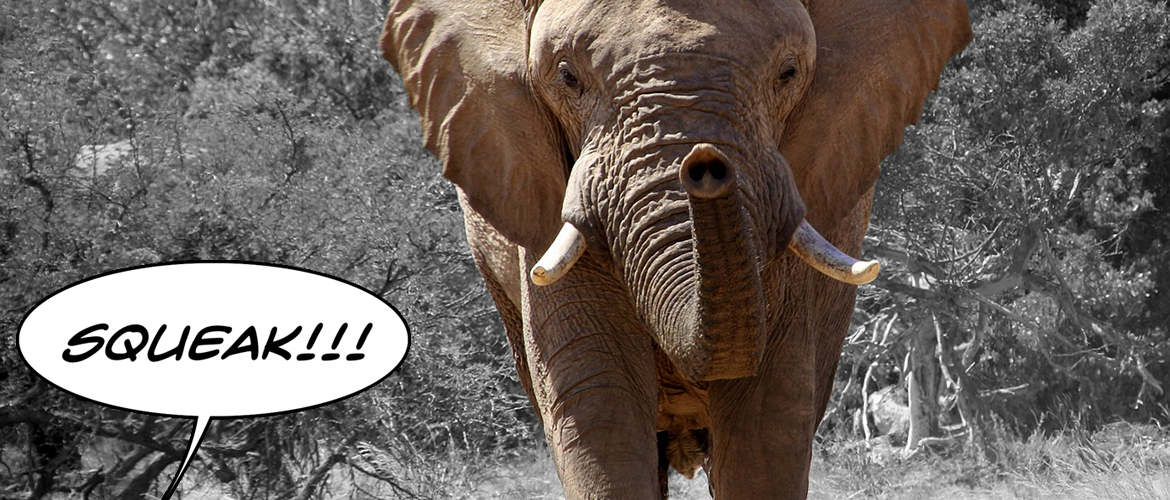David versus Goliath. Jack versus the giant. Elizabeth Taylor versus any of her seven husbands.
When it comes to stories pitting the underdog against the powerful, all of them pall against Mickey versus Dumbo. That’s right, the timeless story of a mouse toppling an elephant is nothing short of inspirational. In fact, it’s more than inspirational.
It’s a lie.
Elephants are no more afraid of mice than ExxonMobil is of the IRS. But don’t take my word for it. Check the internet. You’ll find that everything I’ve said is true.
Also, according to the internet, it’s false.
But after reading dozens of research papers, examining many video clips, and streaming Dumbo on a rainy afternoon, I can confidently distill my conclusion so it fits into a single tweet.
#Myth.
According to scientists and animal behavioralists, it’s far more likely that elephants suffer from the same problems as Baby Boomers. They have poor eyesight and startle easily.
Like many myths, the idea of mice dominating the most powerful of its animal brethren is, itself, based on other myths. According to “The Mouse in Fables” a research paper by Warren R. Dawson published in Folklore (Vol. 36, No. 3), mice are some of the toughest creatures in mythology.
They rescue lions, are the offspring of mountains, promote the values of the common man (or mouse), and ride in chariots drawn by dogs. In these stories their deeds are deeply rooted in their own self-interest, but are nonetheless heroic.
Mice are often cited as being the form a soul takes when it leaves the body, typically for short periods during sleep. Hence, killing a mouse could result in the death of a friend or relative to whom the soul belongs.
(Mice fare less well in the Old Testament where, Dawson wrote, they are “mentioned amongst the unclean animals proscribed by Levitical law.” However, this shouldn’t pose a threat to elephants whom, by most reports, are agnostics.)
But the specific mouse versus elephant myth dates back to A.D. 77 and the writings of Pliney the Elder. In book VIII of his Naturalis Historia, Pliny wrote that elephants “of all animals hate the mouse most, and reject their food if they see that it has been touched by this animal.”
Few people, apparently, felt they were in a position to challenge Pliny the Elder (ask Pliny the Younger why) and instead took what he wrote and ran with it. In time, his story was given a scientific patina by claims that elephants are afraid that mice will climb into their trunks and take up residence. Humans, being quite particular about what they inhale (try offering a house guest a whiff of Ebola virus, for example) found this explanation quite reasonable.
(Elephants are afraid of ants crawling into their trunks, but until Disney makes a movie about Dumbo and Z-4195 no one will care.)
ABC News, in a 2006 effort to put the question to rest, asked Troy Metzler, elephant trainer for the Ringling Bros. and Barnum & Bailey Circus, to bring a mouse and an elephant together. This resulted in one bored pachyderm and one equally bored rodent.
The story might have ended there if Adam Savage and Jamie Hyneman of Mythbusters hadn’t traveled to Cape Town, South Africa to try an experiment of their own. They found that elephants unexpectedly encountering a mouse in an open field stopped where they were, executed a graceful (for an elephant) 180-degree turn, and made elephant tracks out of there.
These results, however, are inconclusive, since Cape Town is in the Southern Hemisphere, where water flushes backwards and Santa Claus wears baggy shorts. In fact, one might argue that the results prove that, in a world where things run in normal directions, elephants are, indeed, non-plussed by mice.
Based on the findings of scientists and animal behavioralists it’s far more likely that elephants suffer from the same problems as Baby Boomers. They have poor eyesight and startle easily.
John Hutchinson, a researcher at the structure and motion lab of the Royal Veterinary College in London, for example, was quoted on the livescience.com website as saying, “Elephants get a bit nervous sometimes when small, fast animals are around them.” (For Baby Boomers, replace “animals” with “children.”)
It’s not mice, per se, that frighten elephants. Any animal terrorist, from a barking dog to a singing Alvin the Chipmunk, that darts near an elephant will do the job.
Nevertheless, there’s a lesson to be learned here when it comes to an underdog fighting against overwhelming odds.
Sneak up on your adversary, make a lot of noise and furtive movements, and if all else fails hope he has a trunk you can crawl into.
Start your Sunday with a laugh. Read the Sunday Funnies, fresh humor from The Out Of My Mind Blog. Subscribe now and you'll never miss a post.
Mind Doodle…
The myth about elephants being afraid of mice crawling into their trunks was apparently promulgated by a late-17th-century Irish physician who concluded that an elephant lacked an epiglottis and would suffocate if a mouse made it into its windpipe. Hopefully he was a better physician than veterinarian. An elephant does, indeed, have an epiglottis.

Nice. Helpful that you linked Z-4195 to imdb. I had confused it with Zyklon B which led me in another direction entirely.
Hi Joe…
Yes, Zyklon B would have changed the tone of the story. I’m sure Disney would find that a tale about poisonous gas used by Germany in WW II had a whiff of impropriety about it.
I’m glad I unmasked that misperception.
— jay
How do you think of these things?!!
Hi Nancy…
The secret is clean living. Also, spicy foods before going to bed.
— jay